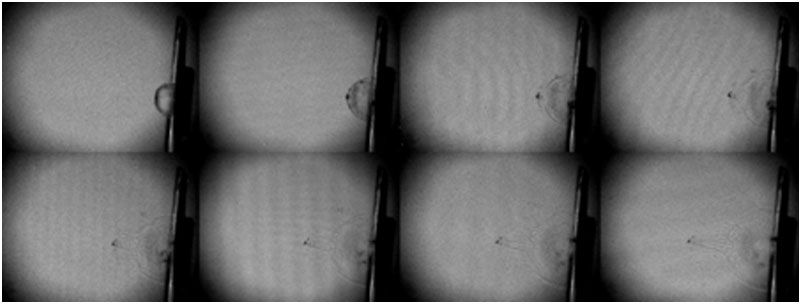Micron sized flyer plates moving at kilometres per second can provide a repeatable method of generating extremely fast projectiles in laboratory conditions. The range of applications include materials testing for defence applications and the initiation of secondary explosives. They are far too small and fast for the naked eye, or a conventional high-speed video camera to capture, so to really understand what is happening during their extremely fast but short flights, it is necessary to capture as many consecutive images as possible using an ultra-high speed framing camera.
Flyer plates are made by a short duration laser or HV pulse applied to a foil of one or more thin layers coated onto a transparent substrate. When the high energy pulse occurs adjacent to the foil a plate/disc is formed and propelled at velocities in excess of 5km/s. These fast-moving plates are typically around 0.1mm - 0.2 mm in diameter and 20μm - 100μm thick.
This sequence, captured by a Specialised Image SIMX16 camera, shows one of these tiny flyer plates being ejected from a platform. The field-of-view is approximately 8.5 mm x 6.5mm and shows the sub-millimetre sized plate moving at more than 6km/s. Such a small, fast-moving object requires very fast frame rates (>15Mfps) and extremely short exposure times (10nS) to provide enough images and freeze the motion blur.
The purpose of these images was to check the consistency of several parameters from multiple tests: 1) Verify complete plate formation 2) Confirm the timing of the plate release relative to the input trigger, which was shared with the camera, 3) Measure the plate velocity and 4) Confirm the direction of flight was perpendicular to the platform. The event was back lit with collimated light using an SI-LUX laser. This shows the plate and debris as a clearly defined shadow and allows the generated shockwaves to be seen.
This is a typical application our SIM cameras are used for. Despite the inherent difficulties with subject speed and size, the combined solution of a SIMX16 camera and SI-LUX laser was able to capture the required sequences allowing confirmation of the required parameters, and ultimately further the client’s research. Specialised Imaging is the only company capable of providing complete solutions such as this to capture this type of ultra high-speed event.




























